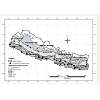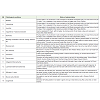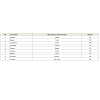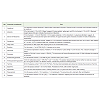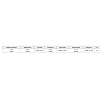Phyto-Chemical Study of Termite’s Mushroom in Nepal: An Ethnomycological Approach
Hari Prasad Aryal1* and Usha Budhathoki2
Corresponding author: Hari Prasad Aryal, Bhairahawa Multiple Campus, Siddhathanagar, Institute of Science and Technology, Tribhuvan University, Nepal,; E-mail: hahariprasadaryal06@gmail.com
1Bhairahawa Multiple Campus, Siddhathanagar, Institute of Science and Technology, Tribhuvan University
2Central Department of Botany, Kirtipur, Kathmandu, Tribhuvan University, Nepal
Citation: Aryal HP, Budhathoki U. Phyto-Chemical Study of Termite’s Mushroom in Nepal: An Ethnomycological Approach. J Plant Sci Res. 2015;2(2): 121.
Copyright © 2015 Hari Prasad Aryal et al. This is an open access article distributed under the Creative Commons Attribution License, which permits unrestricted use, distribution, and reproduction in any medium, provided the original work is properly cited.
Journal of Plant Science & Research | ISSN: 2349-2805 | Volume: 2, Issue: 1
Submission: 31/03/2015; Accepted: 15/04/2015; Published: 21/04/2015
Abstract
This paper reports on the qualitative hytochemical analysis of Termitomyces mammiformis R. Heim belongs to family Tricholomataceae found in Tarai and Midhill of Nepal. It was collected from the termite nest of the forests in West, Centre and East of tropical, subtropical and temperate region. The sample was harvested fresh, sundried, pulverized and analyzed according to standard procedures. Screening revealed the presence of alkaloid, carotenoid, steroid, triterpenoids, fatty acid, emodins, flavonoid and coumarin in ethereal, anthracene glycoside, anthocyanadine glycoside in methanolic and tannins, saponins, glycosides, polyurenoid and polyoses in the aqueous extracts respectively. There were significant differences in the phytochemical composition of the samples collected from three ecological belts and three phytogeographic regions among the west Siwalik was the best. Its ethno mycological knowledge of different ethnic groups was also incorporated. There was definite co-relation between the traditional application of Termite’s mushrooms and possession of secondary metabolites, which supports the scientific basis for the traditional medicinal system. Results showed that the consumption of wild edible mushroom that act as a good dietary supplement and it may be valuable in drug development.
Keywords: Macro-fungi; Local-medicines; Socio-economy
Introduction
All over the world more and more attention is focused on phytochemical research. Phytochemicals are the natural substance of vegetable origin, which provide arrange of drugs for a number of diseases. Many phytochemicals are reasonably heat stable and do not appreciably lost during conventional cooking. An analysis of various plant species is necessary in linking biodiversity and dietary diversity and health. Its composition data can provide useful information to promote sustainable use of biodiversity for food security and health and wellness [1].
Phytochemicals are the major bioactive compounds which provide health benefits and also found to be associated with the inhibition of atherosclerosis and cancer [2]. Edible mushrooms has become an integral part of the normal human diet and considered as nutraceutical product [3,4]. Mushrooms not only provide nutrition, but also prevent diseases and ensure good health and longevity [1]. Phytochemicals are not nutritive but make food functional. Mushroom produce a wide range of secondary metabolites having high therapeutic value, such as antioxidant, antitumor, antibacterial, antiviral, cholesterol lowering, hematological agents and immunomodulating properties [5,6]. These chemicals also used for protection against chronic diseases such as diabetes, antioxidative, anticarcinogenic, hepatoprotective properties [7,8].
Chemical screening of different species of mushrooms contain different chemicals such as Acids and alkaloids, Amatoxin, Psilocybine, Coprin, Helvellic acid, Muscarine, Ibutenic acid, which are toxic to human health either mycetism or mycotoxicoses [9]. The increased interests in consumption of mushrooms as food, in the cure of diseases, and for bioremediation have generated a lot of interest in recent time [10,11].
A high diversity of wild edible mushrooms is must important due to high climatic and floral diversity of Asia. They are consuming high by rural population as well as elsewhere. Herein, we report the chemical analysis of wild edible T. mammiformis mushroom collected from tropical to temperate eco-zones of Nepal.
There are seventy five medicinal mushroom species have been reported from Nepal [12-14]. Medicinal plants are an integral part of the diverse traditional medical practices in Nepal and are codified in traditional medical systems such as Chinese, Ayurveda, Unani, Siddha, Homeopathy, Amchi, etc. [15]. Crude-drugs are commonly given in the form of powder, decoctions, and infusions or in ointment forms. T. mammiformis are not only an important source of food for local people but this also uses them for medicinal purpose for treatment for different types of disease and ailments (Table 1).
Hence, the preparation of monographs of wild edible mushroom T. mammiformis that would provide a systematic account on their phytochemical profiles is in urgent need for standardization of the traditional medicinal herbs, therapeutic benefits and their possible toxic effects. This study aimed to provide information on secondary metabolites of the T. mammiformis of Nepal.
Method
Ethnomycological Survey
Information were collected using an Anthropological field technique, Participatory Rural Appraisal (PRA), involving direct interviews and discussion with local people by [16] direct observation on the way different macrofungi have been collected and used. The documented information was verified by questionnaire, by
consulting relevant literatures and by gathering key information from village elders. The gathered ethnomycological data was authenticated by cross questionings with other community of the same or other localities by referring the same questionnaire and samples as well as by relevant reference and specimen consultation. The survey was done at twenty-seven sites and its adjoining area of Tarai and Midhill of Nepal (Table 2).
Tribal information of T. mammiformis
During present study the ethnomycological information was collected from tribals viz.Baraei, Bhujel (Khawas), Bote, Chamar, Chhanthal, Darai, Damaei, Dhimal, Dusad, Gaaeene, Gurung, Jhangar, Kami, Koeeri, Kumal, Kurmi, Limbu, Magar, Majhi, Musahar, Newar, Praja (Chepang), Rai, Rajbansi, Santhali, Sarki, Sherpa, Tharu, Thakali, Thakuri and Tamang (Table 3).
Collection
Surveys were under taken and specimens collected from 15th to 31st May and from 1st June to 31st October in 2010 and 2011 respectively, from the termite nest of the forests between 26º44’08’’ and 29º06’32’’N latitude and 80º18’02’’ and 88º08’27’’E longitude of Nepal (Figure 1). The local names of specimen along with its traditional uses by native people were noted on the spot (Table 1-3). The collected specimen was brought to the laboratory, Central Department of Botany, Tribhuvan University, Kathmandu, Nepal, for identification.
Table 1: Traditional use of T. mammiformis for the treatment of different types of disease and ailments in the studies area.
Identification
The samples were identified using Heim [17], Rawla et al. [18], Leelavathy et al. [19], Piearce [20], Vander & Eicker [21], Pegler and Vanhaecke [22] and on line data base such as: www.biodiversitylibrary. org [23], www.indexfungorum.org [24], www.jstor.org [25], www. mycobank.org [26], www.tropicos.org [27]. Voucher specimens are deposited in Natural History Museum Tribhuvan University. Its Accession number is NHM TU 2-2-1678.
Processing of the specimen
The mushroom was uprooted, washed and they were oven dried for 48 hours at 40°C. They were turned repeatedly to avoid the microbial growth. The sample was pulverized using a manual blender and stored in a labeled air-tight container before analysis.
Phytochemical Screening
The experiment was carried out in Laboratory of Department of Plant Resource, Kathmandu, Government of Nepal. It was conducted according to standard methods described by Ciulei, [28] (Table 4). Briefly, 10 gm of powdered sample from each site was first extracted with petroleum ether using Soxhlet extractor until 6 hr or until colour change, then with ethyl alcohol and finally with water. The obtained solutions in each extraction process were filtered through whatman filter paper No.1 and concentrated up to 20-25 ml using rotary evaporator at 40ºC.
Statistical Analysis
Variation of concentration of individual chemical compounds in east, center and west Nepal was tested. Similarly those variations were tested among the sample of Tarai, Siwalik and Midhill, using same test, by Pearson’s [29] chi square test. Difference were considered to be significant at p< 0.05 (Tables 5 & 6).
Table 5: Results of P and X2 on the variation of phytochemicals along with phytogeographic north-south gradients (Tarai, Siwaliks and Midhillaregion) with its frequencyof each chemical at different eco zone North-South gradient (Tarai, Siwalik and Midhilla).
Table 6: Results of P and X2 on the variation of phytochemicals along with phytogeographic east-west gradients (East, Central and West region) with its frequency ofeach chemical at different eco zone.East west gradient (East, Central and West Region).
Results
In the present investigation, three samples were analyzed from each region (Table 3), and fifteen major chemical constituents have been found in the extracts of T. mammiformis during analysis, where volatile oil is almost absent, among the tested samples. Generally frequency of high concentration on north-south gradients of alkaloids, steroid, triterpenoids, carotenoid, coumarin, saponins and glycoside are highest in Midhill and gradually decrease Siwalik to Tarai range (except steroid in Tarai) (Appendix IA), whereas fatty acid, tannin polyurenoid and polyoses are gradually decreases from Tarai to Midhill through Siwalik (except fatty acid and polyoses). Herein we found emodine almost equal in the entire eco zone (except in siwaliks) and flavonoid, anthracene glycoside and anthocyanadine glycoside almost absent (except flavonoid in Siwalik & anthracene & anthocyanadine glycoside in Midhill, respectively). Similarly frequency of high concentration on east-west gradients of alkaloid, steroid, triterpenoids, carotenoid, emodine, polyurenoid and polyoses are highest in east and gradually decrease centre to west (Appendix IB), (except steroid, polyurenoid& polyoses in centre and emodine in west, respectively). Whereas in fatty acid, saponins, tannin and glycoside the result shows that concentration were found highest in west and gradually decrease to the east through center (except fatty acid in centre & tannin in the east & west). The flavonoid, anthracene and anthocyanadine glycoside are almost absent (except flavonoid in east & anthracene & anthocyanadine glycoside in west respectively). Herein we found coumarinequal in the entire eco zone.
Likewise, there was significant difference in alkaloid, steroid, triterpenoids, fatty acid, coumarin, anthracene glycoside and polyoses, contains among the tested sample of three different ecozones of north-south gradients of tropical to temperate region of Nepal (Table 5). Similarly there was also significant difference in steroid, triterpenoids, fatty acid, emodine, anthracene glycoside, tannin, glycoside, polyurenoid and polyoses contain among the tested sample of three different eco-zones of east-west gradients of tropical to temperate region of Nepal (Table 6).
Discussion
The plants which are rich in a wide variety of secondarymetabolites are generally superior in medicinal property and exhibit physiological activity at a particular dose [30,31]. Termitomyces species has ability to suppress postprandial hyperglycemia caused by prolonged high blood glucose level associated with diabetes [32,33]. Phytochemicals such as alkaloid, steroid, triterpenoids, flavonoid, anthracene, saponins, tannins and glycosides are also found in T. reticulates [34]. Similarly, fatty acids in T. clypeatus [35] and T. letestui their essential fatty acids are required for the promotion of a variety of body biochemical function. These are potential nutritional food for individuals susceptible to diabetes [36].
Mushrooms generally contain low fat and oil content [37,38]. This statement also supports our experimental work. Because of it, they are recommended as good source of food supplement for patients with cardiac problems or at risk with lipid induced disorders. Mushrooms need antibacterial and antifungal compounds to survive in their natural environment [6]. Hence, they are rich sources of natural antibiotics, these wild macro-fungi; possess inhibitory potential against bacteria associated with wastewater and leftover foods and also a potential source of useful drugs. Still now large number of the unknown species of mushrooms whose health promoting properties are unknown. This is because there are little or no information about these mushrooms and their medicinal potentials. Phytochemicals are responsible for their nutritional and therapeutic uses. These results therefore not only make these wild edible mushrooms T. mammiform is popular to consume as food sources but may also be valuable in drug development.
T. mammiformis have food and medicinal significance, used as vegetable, has therapeutic use and its soup is also used as tonic (Table 4). Hence, it is necessary to identify the biological and pharmacological potential of mushrooms especially of wild edible mushrooms, which are collected indigenously (Table 1). It is also necessary to doresearch in identifying and isolating different species of mushrooms having nutraceutical and medicinal properties to commercialize. The production in large scale level would create a lot of employment opportunities especially in economically deprived rural area which plays a vital role in enrichment of the socio- economic life. Besides their consumption, the local medicine also paves the way for theupbringing new industries.
Based on the result of these finding, it can be concluded that T. mammiformis have high concentration of diverse phytochemicals and are potential of medicinal value. The species contain different chemical concentration of bioactive compounds even in same ecological zone. Concentration of chemicals may be affected by climatic variation. There was co-relation between the traditional application of mushrooms and possession of secondary metabolites. This result may be useful to future workers to select a group of plants having similar chemical constituents to isolate biologically active principle or prepare remedies for particular case. Bioactive compounds with antibacterial properties can also be sourced from this underutilized macrofungi present in wild state.
Acknowledgments
The authors would like to acknowledge Nepal Academy of Science and Technology for providing research grant. Thanks are due to Central Department of Botany, Tribhuvan University and Department of Plant Resource, Government of Nepal for providing the laboratory facilities. The authors are also grateful to the Institute of Science and Technology for granting my study leave to one of them (Mr. Hari Prasad Aryal). Sincere thanks are extended to local people of the study area for necessary help and providing information.
References
- Rodriguez EB, Flavier ME, Rodriguez-Amaya DB, Farfán JA (2006) Phytochemicals and functionalfoods. Current situation and prospect for developing countries. SegurançaAlimentar eNutricional, Campinas 13: 1-22.
- Klimczak I, Malecka M, Szlachta M, Gliszczy ASW (2007) Effect of storage on the content of polyphenols, vitamin C and the antioxidant activity of orange juices. J food composition and analysis 20: 313-322.
- Chang ST, Buswell JA (2003) Medicinal mushrooms: A prominent source of nutraceutical forthe 21st century. Current Topics in Nutraceutical Research 1: 257-280.
- Mau JL, Lin HC, Song SF (2002) Antioxidant properties of several specialty mushrooms. Food Research International 35: 519-526.
- Wasser SP, Weis AL (1999) Medicinal properties of substances occurring in higher Basidiomycetes mushrooms: current perspectives (Review). International Journal of Medicinal Mushrooms 1: 31-62.
- Wasser SP (2002) Medicinal mushrooms as a source of antitumour and immune stimulating polysaccharides. Appl Microbiol Biotechnol 60: 258-274.
- Johnson MB, Heineke EW, Rhinehart BL, Shietz MJ, Bambart R. L, et al. (1993). MDL 29311: Antioxidant with marked lipid and glucose lowering activity in diabeticrats and mice. Diabetes 42: 1179-1186.
- Rupasinghe HP1, Jackson CJ, Poysa V, Di Berardo C, Bewley JD, et al. (2003) Soyasapogenol A and B distribution in soyabean (Glycine Max L. Merr) in relation to seedphysiology, genetic variability and growing location. J Agric Food Chem 51: 5888-5894.
- Duffy TJ (2008) Toxic fungi of western North America : 166.
- Chang ST (1990) Mushroom Production in South East Asia, Mushroom. Newsle Tropic 4: 5-10.
- Bushwell YA, Chang ST (1993) Edible Mushroom. Attributes and applications in genetic sand of edible mushrooms: 297-334.
- Adhikari MK (2009) Researches on the Nepalese mycoflora. Kathmandu, Nepal: AlkaBastiMarga, Adhikari KS: 82.
- Aryal HP, Budhathoki U (2013) Termitomyces albuminosus(Berk.) Heim aNew FungalRecord from Arghakhnchi, Nepal. OAKS 9: 44-47. Nainital, India.
- Aryal HP, Budhathoki U, Tiwari RD (2014) Termitomyces microcarpus (Berk. &broome) R. Heim: ANew records from Nepal. J Mycol Plant Pathol 44: 13-18.
- Manandhar NP (2002) Ethnomedicinal plants diversity and their conservation in Nepal. In V. K. Singh, J.N. Govil, G. Singh (Eds.) Recentprogress in medicinal plants (Vol. 1, pp. 41-46).USA: Publ. StudiumPress LLC.
- Heim R (1977) Termites et Champignons. Les termitophilesd’Afrique Noire at d’asieMeridionale. Paris, France: SocieteNovelle des Edition (p. 205) Boubee, Paris.
- Rawla GS, Arya S, Sarwal BM (1983) Species of Termitomyces Heim. from Chandigarh, India. Bibliothecamycologica 91. J Cramer 13-21.
- Leelavathy KM, Flower SL, Suja CP (1985) The genus Termitomyces in India. Indian Mushroom Science 2: 402-407.
- Piearce GD (1987) The genus Termitomyces in Zambia. The mycologist 1: 111-116.
- Van der WGCA, Eicker A (1990) Species of Termitomyces in South Africa. Mycological Research 94: 923-937.
- Pegler DN, Vanhaecke M (1994) Termitomyces of Southeast Asia. Kew Bulletin, UK 49: 717-736.
- www.biodiversitylibrary.org
- www.indexfungorum.org
- www.jstor.org
- www.mycobank.org
- www.tropicos.org
- Ciulei I (1982) Practical manuals on the industrial utilization of chemical and aromatic plants. Methodology for analysis of vegetable drugs. 1st eds. Bucharest: Ministry of Chemical Industry: 67.
- Pearson, K. (1990) X. On the criterion that a given system of deviations from the probable in the case ofa correlated system of variables is such that it can be reasonably supposed to have arisen fromrandom sampling. Philosophical magazine series 5 50: 157-175.
- Gurib-Fakim A (2006). Medicinal plants: Traditions of yesterday and drugs of tomorrow. Mol Aspects Med 27: 1-93.
- Muetzel S, Becker K (2006) Extractability and biological activity of tannins from various treeleaves determined by chemical and biological assays as affected by drying procedure. Animal Feed Science and Technology 125: 139-149.
- Moordian AD, Thurman JE (1999) Drugs therapy of postprandial hyperglycemia. Drugs 57: 19-29.
- Matsuura, H., Asakwa, C., Kurimoto, M.,&Mizutani, J. (2002) Alpha Glucosidase inhibitor from theseeds of balsam pear (Momordica charantia) and the fruit bodies of Grifola frondosa. Biosci Biotechnol Biochem 66: 1576-1578.
- Loganathan JK, Gunasundari D, Hemalatha M, Shenbhagaraman R, Kaviyarasan V (2010) Antioxidant and phytochemical potential of wild edible mushroom Termitomycesreticulatus: Individual cap and stipe collected from south eastern part of India. International Journal of Pharmaceutical Research & Allied Sciences 1: 62-72.
- Baraza LD, Joseph CC, Moshi MJ, Nkunya MHH (2007) Chemical constituents andbiological activity of three Tanzanian wild mushroom species. Tanz J Sci 33: 1-7.
- Arasmus U (1995) Fats that heal fats that kills (pp. 1-465).Burnaby, BC, Canada: Alive Books.
- Okwulehie IC, Odunze ET (2004) Evaluation of the Myco-chemical and mineral composition of some tropical edible mushroom. Journal of sustainable agriculture and environment 6: 63-70.
- Aryal HP, Budhathoki U (2013) Termitomyces albuminosus(Berk.) Heim aNew FungalRecord from Arghakhnchi, Nepal. OAKS 9: 44-47. Nainital, India.
- Lindequist U, Niedermeyer THJ, Julich WD (2005) The pharmacological potential of mushrooms - Review. Evidence based complementary alternative medicine 2: 285-299.

